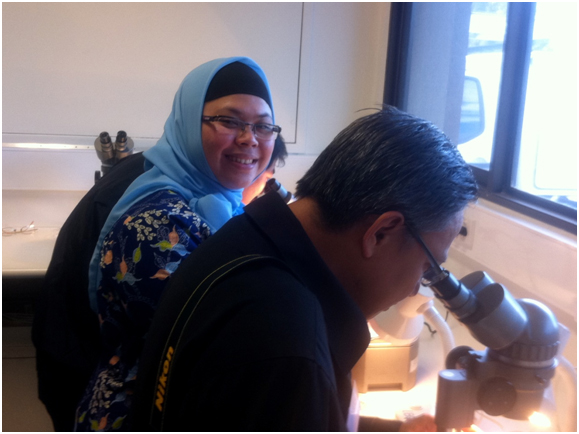
© 2009-2012 CRC for National Plant Biosecurity | Disclaimer
![]()


PhDs
Congratulations to Steven Coventry and Kylie Ireland, both of whom have recently submitted their theses for examination. Steve investigated the biotic factors that affect the dispersal of rain-splashed asexual spores (conidia) and wind-borne sexual spores (ascospores), using Ascochyta of chickpea as a model. Steve has now taken up employment with the Department of Agriculture and Food Western Australia (DAFWA). Read more about Steven’s PhD project in this edition of The Leaflet [1].
Kylie’s study had a strong international focus, looking at the susceptibility of Australian plant species, grown and sold as ornamentals within parks and gardens, to Phyophthora ramorum. As this pathogen is not present in Australia, Kylie spent a large part of her PhD based in the USA gaining firsthand experience in the biology, ecology and management of this disease. Kylie has recently taken up a position with the Queensland Government where her focus will be on myrtle rust. More information about Kylie’s research project [2] is available here.
Grains workshop
The CRCNPB – in conjunction with Cooperative Bulk Handling (CBH) and the Crawford Fund – recently supported a workshop in correct grain storage and biosecurity for some of Australia’s near neighbours. Ten representatives from flour milling companies in Indonesia, Malaysia, Bangladesh, Sri Lanka, Singapore and Vietnam travelled to Perth to gain an insight into the control of grain storage pests, to participate in training exercises to reduce their grain losses, and to improve their biosecurity practices.
The training provided participants with experience in the principles of grain storage and fumigation to control pests and thus avoid losses, estimated at 10% worldwide. The course also explained the need for better grain protection and biosecurity for international import and export trade. CBH – who have strong relationships with grain milling companies throughout Asia – hosted the trainees at their Australian Grain Centre Laboratory and Metro Grain Centre. The participants also received in-the-field experience of on-farm storage and experimental silo trials at Arthur River and Lake Grace, and a ‘behind the scenes’ tour of the Australian Quarantine Inspection Service (AQIS) facilities at Perth airport.
All participants mentioned the value of the training and the importance of viewing the value chain, from the farm to storage. All participants recognised that they have been applying too much fumigant to their stored grain and realised they could save their companies a significant amount of money by using less. A number also admitted that they apply the fumigant incorrectly and do not use sealed silos, which negates the purpose of the fumigation. A number of the participants were going to implement changes to their fumigation programs on their return home.
The five-day workshop was held at Murdoch University and was delivered by Pat Collins, Michelle Chami (DAFWA), YongLin Ren, James Newman, Michael Thompson, Chris Edmeades and Kirsty Bayliss. The ABC interview (podcast) can be downloaded from the ABC website [3].

James Newman (Murdoch University) introducing participants to the Giant Ram in Wagin. Left to right – James Newman, Hendra Tanumihardja, Elmar Nau, Sultan Ahmed, Yannes Piung, Arief Zakaria, Seymour Magabe, Kelly Lai, Thoa Kim, Imron Tengriano, Rasheen Bappu.

Ms Seymour Magabe and Mr Arief Zakaria, both from Indonesia, identifying stored grain pests under the microscope in the Murdoch postharvest laboratory.
Links:
[1] http://www.crcplantbiosecurity.com.au/content/answer-blowing-wind
[2] http://www.crcplantbiosecurity.com.au/content/research-reveals-new-threat-native-forests
[3] http://www.abc.net.au/rural/wa/content/2011/07/s3273959.htm